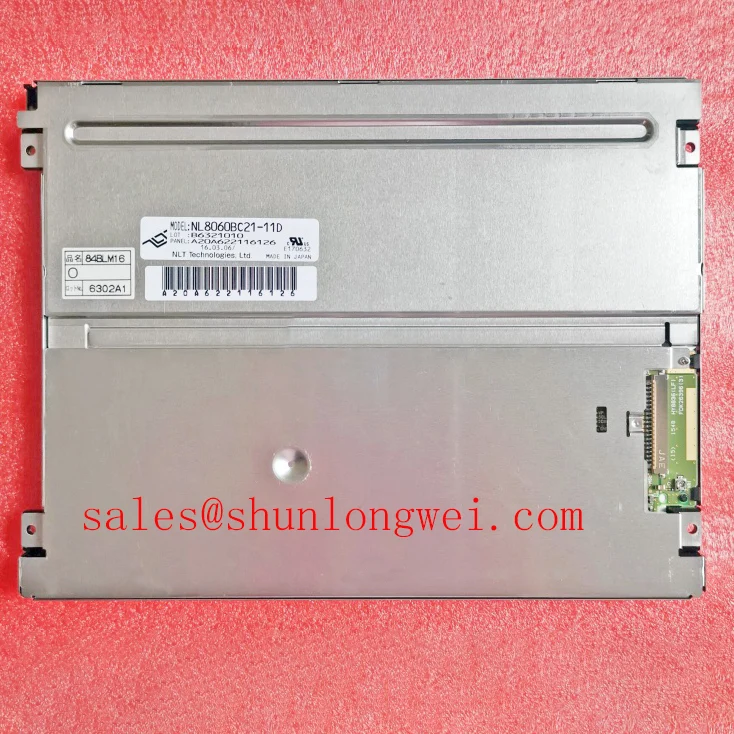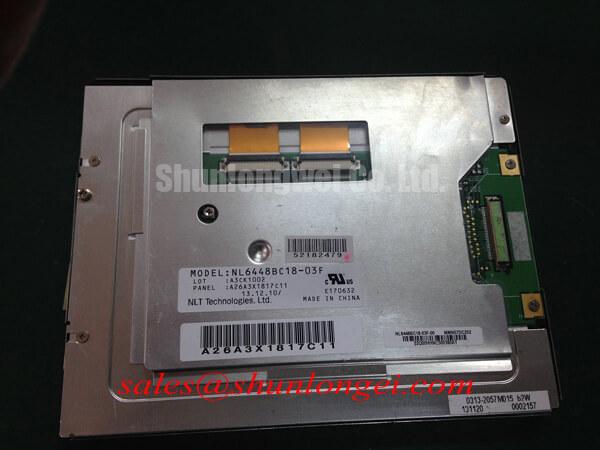Content last revised on October 29, 2025
NL160120BC27-14: A 21.3-inch UXGA Display Engineered for Mission-Critical Clarity and Longevity
Product Overview
The NL160120BC27-14 is a high-performance 21.3-inch amorphous silicon TFT-LCD module designed for applications where image fidelity, color accuracy, and operational stability are paramount. Delivering a crisp UXGA resolution, this display is engineered for sustained performance in professional environments. Key specifications include: 1600x1200 Resolution | 550:1 Contrast Ratio | 250 cd/m² Brightness. This combination of high resolution and robust optical characteristics ensures precise image reproduction. What is the primary benefit of its SA-SFT technology? Exceptionally wide and symmetrical viewing angles for multi-user visibility. The module's design focuses on delivering consistent, high-quality visuals for diagnostic, monitoring, and industrial control systems. For specialized applications demanding superior image stability and color precision, such as medical imaging or graphic design, the NL160120BC27-14 provides a reliable and clear visual interface.
Key Parameter Overview
Decoding the Specs for Optical Precision and System Integration
The technical specifications of the NL160120BC27-14 are optimized for high-information-density applications. Each parameter is a critical piece of the puzzle for system designers aiming to achieve superior visual performance and reliable integration.
| Parameter | Value | Engineering Value & Interpretation |
|---|---|---|
| Screen Size | 21.3 inches | Provides a large, immersive viewing area suitable for detailed data analysis and multi-window displays in control rooms or diagnostic workstations. |
| Resolution | 1600 x 1200 (UXGA) | The high pixel density (94 PPI) ensures sharp, clear rendering of fine lines, text, and complex graphics, which is critical for medical imaging or detailed schematics. |
| Display Technology | SA-SFT, Normally Black | Super-Advanced Super Fine TFT (SA-SFT) technology provides ultra-wide viewing angles and superior color fidelity. The "Normally Black" characteristic means pixels are black in the off-state, delivering deeper blacks and a higher perceived contrast. |
| Viewing Angle (CR≥10) | 85°/85°/85°/85° (L/R/U/D) | Symmetrical viewing angles ensure that image color and contrast remain consistent regardless of the observer's position. This is vital for collaborative environments where multiple users view the same screen. |
| Contrast Ratio | 550:1 (Typ.) | A strong contrast ratio distinguishes clearly between bright and dark areas of an image, enhancing depth and readability, particularly for grayscale-intensive applications like radiology. |
| Interface | LVDS (2 ch, 8-bit) | The dual-channel Low-Voltage Differential Signaling interface is a robust, high-bandwidth standard for industrial displays, offering excellent noise immunity and supporting the high data rate required for UXGA resolution. |
| Operating Temperature | 0°C to 55°C | Engineered for stable operation within controlled indoor environments such as hospitals, laboratories, and industrial control rooms. |
Download the NL160120BC27-14 datasheet for detailed specifications and performance curves.
Application Scenarios & Value
System-Level Benefits in Medical Diagnostics and Industrial Process Control
The NL160120BC27-14 is not merely a component but a foundational element for systems where visual accuracy directly impacts outcomes. Its specific combination of UXGA resolution and SA-SFT technology makes it a prime candidate for high-stakes applications.
Consider the challenge faced by a radiologist interpreting a digital X-ray or CT scan. Subtle grayscale variations can indicate critical diagnostic information. The NL160120BC27-14's 550:1 contrast ratio and 8-bit color depth (16.7M colors) provide the nuance needed to distinguish between different tissue densities. Its SA-SFT technology ensures that this crucial information remains consistent even when viewed from an angle, allowing for accurate collaborative review. This is a significant advantage over standard TN panels, where color and contrast shifts can lead to misinterpretation.
In an industrial control room monitoring a complex manufacturing process, operators need to absorb vast amounts of data from multiple sources on a single screen. The 21.3-inch diagonal and 1600x1200 resolution offer ample screen real estate to display SCADA interfaces, process flow diagrams, and alarm statuses without compromising clarity. The display's stable performance and standard LVDS Interface simplify integration into existing industrial computing hardware, reducing development time and ensuring long-term system reliability. For applications that require even higher resolution for multi-stream video feeds or ultra-detailed mapping, the G270ZAN01.1 offers a 4K UHD solution in a larger form factor.
Technical Deep Dive
An Analysis of SA-SFT Technology for Uncompromised Visual Fidelity
The core of the NL160120BC27-14's optical performance lies in its Super-Advanced Super Fine TFT-LCD technology. Unlike conventional Twisted Nematic (TN) panels where liquid crystal molecules twist horizontally, SFT and other IPS-type technologies align the crystals parallel to the glass substrates. When a voltage is applied, the crystals rotate in-plane to allow light to pass through.
This fundamental difference in liquid crystal orientation is the key to the module's superior viewing angles and color stability. Imagine looking at a picket fence (a TN panel) from the side; the view is quickly obscured. Now imagine looking at a venetian blind with the slats parallel to your view (an SFT panel); you can see through it clearly from a much wider angle. This "in-plane switching" mechanism drastically reduces off-axis color and gamma shift, ensuring the image seen at 85 degrees is virtually identical to the one seen head-on. This is a non-negotiable requirement for medical-grade monitors and professional graphic design displays where color accuracy is mandated by industry standards.
Application Vignette
Case Study: Enhancing Diagnostic Confidence in Medical Imaging Stations
The Challenge: A medical equipment OEM is developing a new line of diagnostic imaging workstations. Their primary engineering challenge is sourcing a display that can accurately render subtle grayscale details from MRI and CT scans while allowing for easy consultation between multiple physicians. The display must be reliable, consistent, and free from the visual artifacts that could compromise a diagnosis.
The Solution: The NL160120BC27-14 is integrated as the primary visual interface. Its UXGA resolution provides the pixel density needed to resolve fine anatomical structures. The 550:1 contrast ratio and "Normally Black" mode deliver deep, true blacks, making faint grayscale variations more perceptible. Most critically, the symmetrical 85-degree viewing angles enabled by SA-SFT technology allow a primary radiologist and a consulting specialist to view the screen from different positions without any loss of diagnostic information. This eliminates the need to huddle in a narrow "sweet spot," improving workflow and collaborative efficiency.
System-Level Benefit: By choosing the NL160120BC27-14, the OEM delivers a workstation that enhances diagnostic confidence. The display's inherent color and contrast stability reduces the risk of misinterpretation, directly contributing to better patient outcomes. The use of a standard LVDS interface also streamlines the design of the embedded system, ensuring compatibility and simplifying the path to regulatory approval for the medical device.
Frequently Asked Questions (FAQ)
Engineering Questions on Implementation and Performance
How does the SA-SFT technology in the NL160120BC27-14 compare to standard IPS panels?
SA-SFT is a proprietary technology from NEC that belongs to the In-Plane Switching (IPS) family. While based on the same core principles of aligning liquid crystals parallel to the substrate, SA-SFT is specifically engineered for high-end industrial and medical applications, often featuring enhancements in contrast, response time, and color purity compared to more common consumer-grade IPS panels.
What are the key considerations when designing a driver board for the dual-channel LVDS interface?
The primary considerations are signal integrity and power delivery. Designers must use controlled impedance traces (typically 100 ohms differential) for the LVDS pairs to prevent signal degradation. Proper grounding and a clean 12.0V power supply rail are essential to avoid noise that could interfere with the display data. It is also critical to ensure the timing controller (TCON) on the driver board is compatible with the 2-channel, 8-bit data format required by the module.
With a CCFL backlight, what is the expected lifespan and what are the end-of-life characteristics?
Cold Cathode Fluorescent Lamp (CCFL) backlights typically offer a lifespan in the range of 20,000 to 50,000 hours to half-brightness. As a CCFL ages, its brightness will gradually decrease. End-of-life is also characterized by potential changes in color temperature (a slight pink or yellow hue) or, in some cases, difficulty in starting up in cold temperatures. System designers should account for this gradual degradation in their maintenance schedules.
Is the NL160120BC27-14 suitable for environments with high ambient light?
With a typical brightness of 250 cd/m² and an antiglare surface treatment, this module is well-suited for standard indoor environments like offices, labs, and control rooms. However, it is not designed for direct sunlight readability. For outdoor or very bright industrial settings, a display with a brightness rating of 800 cd/m² or higher would be a more appropriate choice.
How does the 1600x1200 resolution on a 21.3-inch screen impact UI/UX design for control software?
The 94 PPI pixel density provides a sharp, detailed canvas. UI designers can use smaller fonts and more detailed icons than on lower-resolution displays, allowing for more information to be presented on a single screen. However, it is crucial to ensure that touch targets and critical information displays are still large enough for easy interaction and at-a-glance readability, following established HMI design principles for the target application.
An Engineer's Perspective
From a design standpoint, the NL160120BC27-14 represents a class of displays focused on stability and predictability. Its specifications are not about pushing a single metric to its extreme but about delivering a balanced, high-fidelity performance profile that can be trusted for years of operation. The choice of a proven LVDS interface and a CCFL backlight underscores a design philosophy prioritizing long-term reliability and consistency over adopting newer technologies that may have a less established track record in critical industrial and medical fields. This makes it a strong contender for system upgrades or new designs where the display's performance must be a known, reliable constant.










